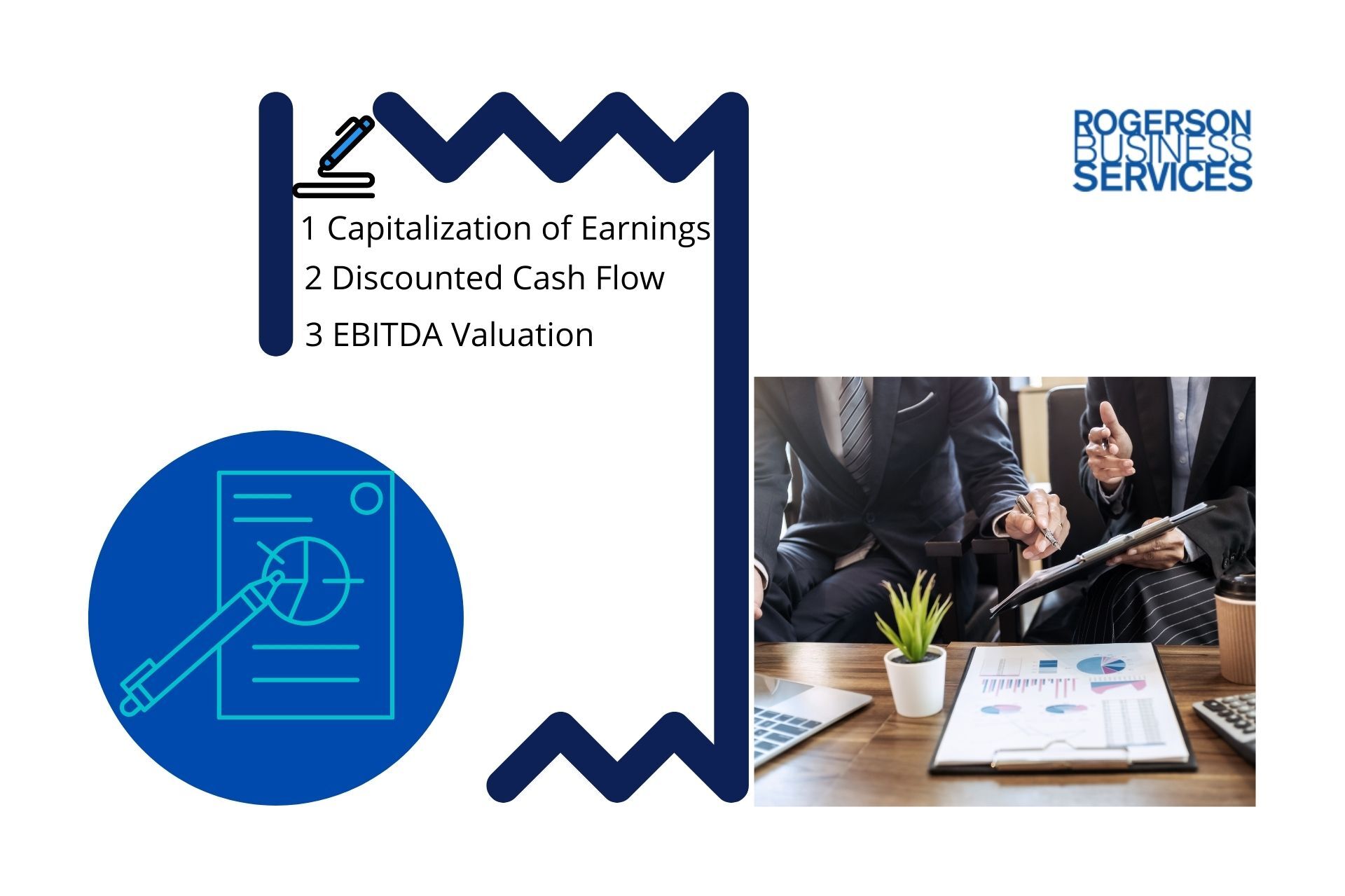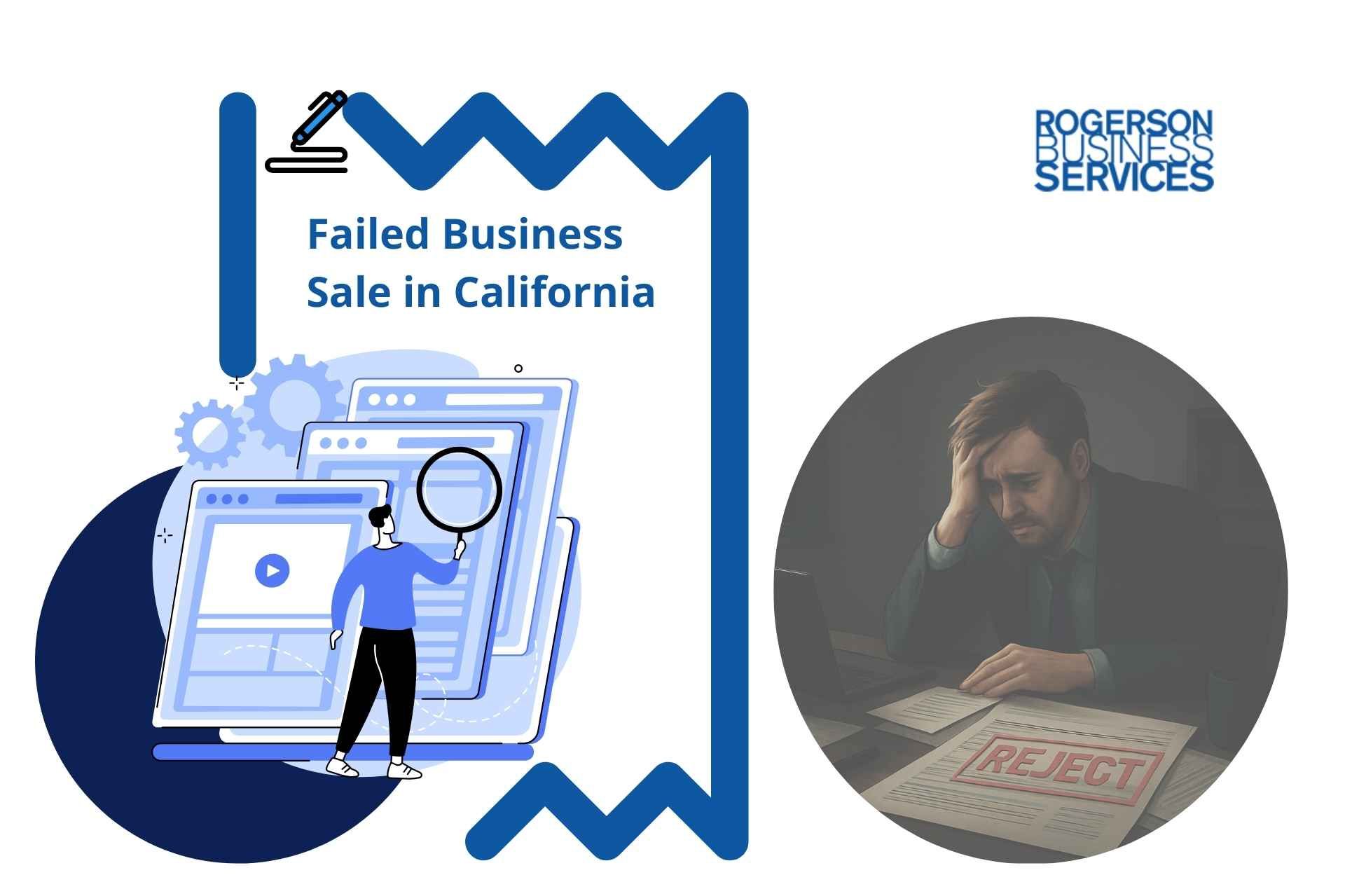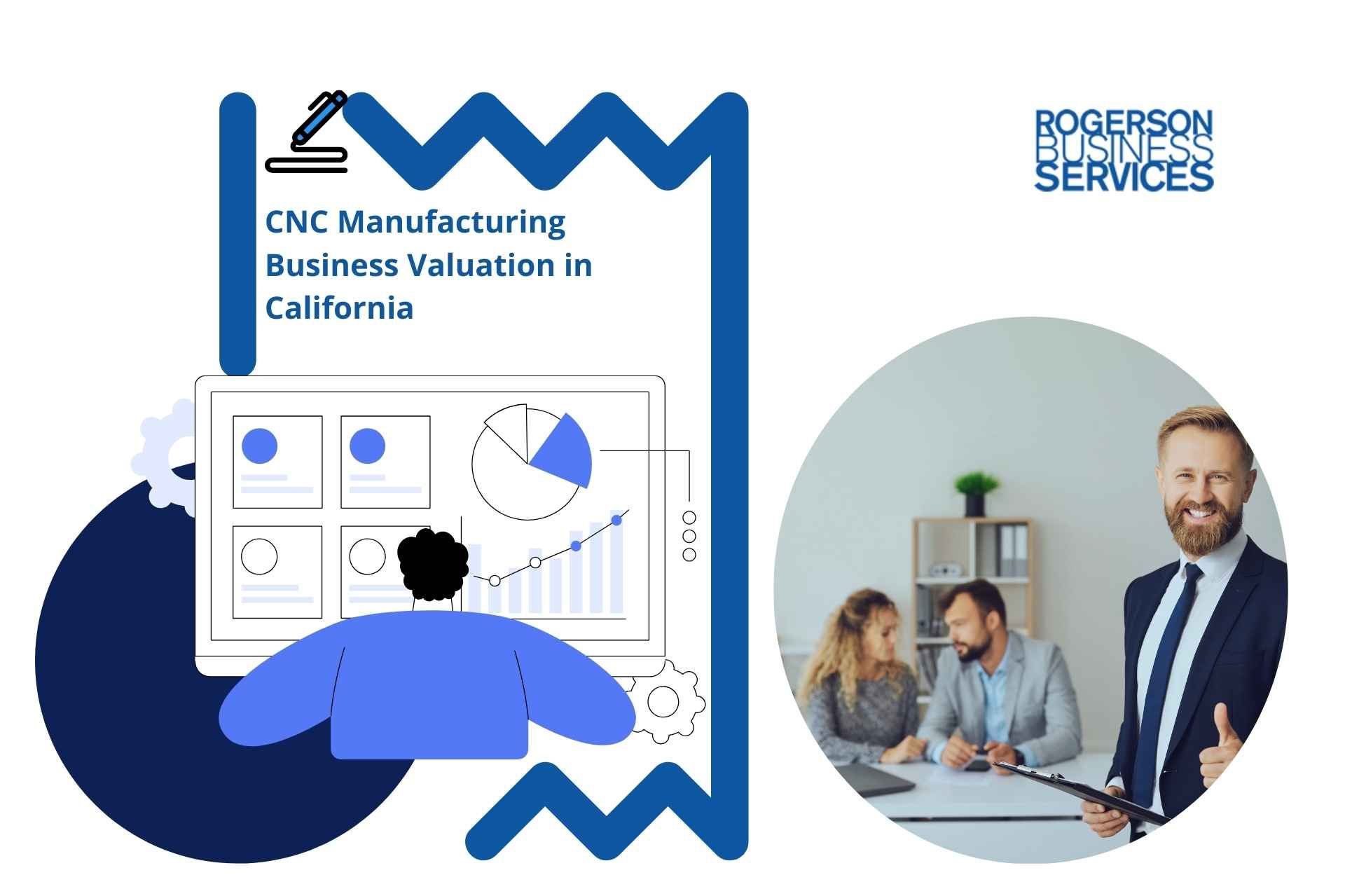Income Approach Valuation Formula | What’s My Business Worth
Income Approach Valuation Formula
- Capitalization of Earnings Formula: Yearly Future Earnings/Required Rate of Return) = Business Value
- Discounted Cash Flow Formula: Valuation = (Cash Flows in the first year) / (Required Rate of Return – Growth Rate)
- EBITDA Valuation Formula: (Earnings Before Interest, Taxes, Depreciation, and Amortization)

An income approach valuation formula is to calculate a company’s present value of cash flow (or future earnings) to determine what's it worth or the company's future value.
Income approach valuation formula by applying a capitalization of earning method as an example:
- Yearly Future Earnings/Required Rate of Return) = Business Value
When you value and sell a business in California, it is an emotional process. As you navigate the excitement of exiting your lifelong business, there are also a lot of things that go into valuing your operations and assets. You can value a company in multiple ways, but we will cover the income approach today. This method involves an analysis of your future earnings, and we discuss the specifics in the article below.
Income Approach Valuation Example
The income approach to business valuation is when a company’s present value of cash flows (or future earnings) determines its value. The cash flows represent the future earnings projections of the business. When an M&A Advisor calculates the business value of a lower middle-market company in California, it must adjust these future cash flows for taxes, growth rates, cost structure, and other factors.
The income approach is an effective indicator because it does not assess historical business transactions within the market. Although future growth rates and return on investment can be volatile, the projections must be as accurate as possible.
Income Approach Methods
There are three different methods for the income approach:
- discounted cash flow approach,
- capitalization of earnings,
- and multiples of earnings. We highlight the key differences between the two below.
Capitalization of Earnings Method
The capitalization of earnings analyzes a company’s value by evaluating the net present value of future cash flows or profits. Its simple formula divides the company’s future earnings by the capitalization rate. The goal of this method is to determine if the company is worth pursuing from the acquirer's perspective and to maximize the business value from the business seller's perspective. It does this based on its current cash flow, its annual rate of return, and its projected future value.
When you use this method for the income approach, use the following formula:
- (Yearly Future Earnings/Required Rate of Return) = Business Value
This approach assumes there is no growth in cash flows. For example, a manufacturing company is up for sale, and buyers want to determine its worth. When the M&A advisor gives the presentation, he highlights that the company’s projected future earnings are $32 million, including a required rate of return at 13%. With the capitalization of earnings formula, the company’s value is:
- ($32 million/13%) = $246.2 million
Based on this formula, the California manufacturing company is worth $246.2 million if its future cash flow continues to produce the projected amount.
Discounted Cash Flow Method
The discounted cash flow method is slightly more detailed than the capitalization of the earning method. This method calculates the value of a business by evaluating the present value of future earnings, in addition to the terminal value’s present value. In this formula, the company’s expected cash flow is the first thing projected.
From there, each cash flow gets discounted into a present value, based on a rate related to the risk. This figure represents how risky it is to receive that cash flow amount at the given time projection. The most effective way to form these projects is through items like working capital, operating costs, capital expenses, and revenue.
The risk-driven discount rate helps us understand the business’s discounted cash flow to the present. The percentage is usually referred to as the WACC, weighted average cost of capital.
The most straightforward formula to calculate this is the Gordon Growth Model. This equation net cash flows for a single year with perpetual growth. Below is the formula:
- Valuation = (Cash Flows in the first year) / (Required Rate of Return – Growth Rate)
How to Perform a Discounted Cash Flow Analysis | Income Approach Formula
M&A Advisors, analysts, and investors all use the discounted cash flow analysis. It is the primary business valuation income approach formula for evaluating the amount of money that is worth paying for a company. Not only is this analysis useful for the buying or selling of a company, but it is also perfect for investing in the company in return for its shares.
The basis of DCF is to apply for any situation in which you want to invest more money in the present day, in anticipation of a return on that investment in the future. The formula for DCF is as follows:
- Discounted Cash Flow = [(CF #1) / (1+r)^1] + [(CF #2) / (1+r)^2] + [(CF #3) / (1+r)^3] + [(CF #n) / (1+r)^n]
In this equation, “r” represents the discount rate, or WACC, while “CF” represents cash flow, and “n” represents the terminal value. To break this down even further:
- Discounted Cash Flow (DCF) is the total of all future discounted cash flows that the initial investment is projected to return. This variable is what the equation solves for.
- CF is the cash flow for a specific year. When we say, “CF #2,” we refer to the cash flow in year 2, and so on.
- R is the discount rate, which we express in decimal format. The discount rate is the ideal return on investment that you want to achieve.
Multiples of Earnings | Income Approach Valuation Formula
When we discuss “multiples,” it is a way to evaluate a single element of a business by comparing two relevant numbers, or metrics. Multiples are convenient because they enable us to compare two different businesses by using these figures when applying the business valuation income approach formula.
These multiples represent a numerical fraction in which the numerator is larger than the denominator. For example, the price-to-earnings ratio (P/E ratio) evaluates the relationship between a stock price and its earnings. From a higher level, the P/E ratio gives us an idea of how much the market is willing to pay to participate in a public company’s earnings. The higher the ratio, the more people will pay.
The earnings aspect is critical because that is what we use to value the company within this method. Earnings tell us how profitable the company is. However, there are many ways to evaluate earnings for a business. You could consider taxes, EBIT (earnings before interest and taxes), or EBITDA (earnings before interest, taxes, depreciation, and amortization).
When we value a company using multiples of earnings, we typically use EBIT. For the multiple, it depends on national standards, including business size and industry type. Buyers and sellers of a lower middle market business in California usually turn to a Certified M&A advisor, business valuation experts, and appraisers, who use a rule of thumb to value the company.
Typically, the national average says that a company sells for approximately 0.6 times its annual sales. However, there are other determinants that we must encounter. Perhaps the buyer will only pay for the company at four or five times earnings if the lower middle-market company already has a strong leadership team and market presence.
If a buyer relies on multiples of earnings to value a company in California, it must consider the following:
- What elements are included (or left out) in the earnings calculation?
- What was the earnings multiple used in this calculation?
- What is the standard earnings multiple used for other businesses in this same industry?
- Besides multiples of earnings, are there any factors that we need to consider in the valuation of this business?
Looking to Value & Sell Your Lower Middle Market Business | Hire an M&A Advisor
Valuing and Selling a business in California's lower middle market segment is a massive project with a lot of moving parts. When you are a retiring business owner, it is completely normal to be emotionally invested in the company. An Experienced & Certified M&A Advisor helps you stay on track by identifying specific milestones and navigating you through the sell-side M&A process. These certified professionals also help you maximize the value of your business before selling. They sit on a vast of business valuation income approach formulas to best determine what's it worth, maximize value, and get it well-positioned for acquisition in the lower middle-market segment.
So, what else does a mergers and acquisition advisor do when it comes to selling a company in California?
First, the M&A advisor assembles the documents needed to perform a business evaluation and sell the company. The M&A advisor will collaborate with company leadership to gather the financial statements to present to the serious buyer.
Secondly, the M&A Advisor will vet, inform, and interview potential buyers. M&A Advisors understand the critical characteristics to look for in a buyer. Other responsibilities include setting up the interviews, addressing buyer concerns and questions, and presenting financial information to the buyers.
Thirdly, an M&A advisor oversees the checklist for due diligence and closing the sale. The overarching objective for the seller is to receive a buying offer via the M&A Advisor. Once this goal is achieved, the advisor will partner with the buyer and seller to ensure the agreement is officially accepted by both people. The M&A Advisor may also work with tax professionals, industry experts, attorneys, and more.
An M&A Advisor also plays a critical role in the following steps:
- Valuing the company to ensure it falls within the market range by using the best business valuation formula - how to calculate business valuation
- Collaborating with the seller to draft documents that will get presented to the market
- Prospecting and contacting potential buyers
- Interviewing the buyers
- Qualifying the buyers
- Assisting in the due diligence process
- Negotiating offers with the buyer and seller
- Facilitating the buyer in getting the correct financing, if applicable
- Assisting the sale by transferring ownership
- Officially closing the deal and taking care of any follow-up issues
Recap Summary: Selling Now Or Later
Valuing and Selling a business in California can be an emotional process. Determining the value of the company, its assets, and operations is also a critical task. To ensure you are getting the most out of your company, you must partner with an M&A Advisor to guide you through the sell-side M&A process. Your business has come a long way, so make sure you maximize the value of your business before selling it successfully.
If you are a retiring business owner looking to exit your lower middle market business in California, here are five tips to get you started:
1. Don't wait until the last minute to start planning your exit. The process of selling a lower middle market business can take a long time, so it's important to start early.
2. Have a clear idea of what you want to get out of the sale. Know your goals and what you're willing to negotiate.
3. Choose the right type of buyer. Not all buyers are created equal, so do your research and find the right one for your business.
4. Be prepared for a lot of due diligence. M&A buy-side due diligence is when buyers will want to know everything about your business, so be ready to provide documentation and answer questions.
5. Be flexible with the terms and conditions of the deal. It's important to be open to negotiation to get the best possible deal for your business.
Rogerson Business Services, also known as, California's lower middle market business broker is a sell-side M&A advisory firm that has closed hundreds of lower middle-market deals in California. We are dedicated to helping our clients maximize value and achieve their desired outcomes.
We have a deep understanding of the Californian market and an extensive network of buyers, which allows us to get the best possible price for our clients. We also provide comprehensive support throughout the entire process, from initial valuation to post-closing integration.
Our hands-on approach and commitment to our client's success set us apart from other firms in the industry. If you consider selling your lower middle market business, we would be honored to help you navigate the process and realize your goals.
If you have decided to value and then sell your lower middle market business or still not ready, get started here, or call toll-free 1-844-414-9600
and leave a voice message with your question and get it answered within 24 hours. The deal team is spearheaded by Andrew Rogerson, Certified M&A Advisor, he will personally review and understand your pain point/s and prioritize your inquiry with Rogerson Business Services,
RBS Advisors
Go to the next article: Part of business valuation to answer what's my company worth series ->
Hey there! Can we send you a gift?
We just wanted to say hi and thanks for stopping by our little corner of the web. :) we'd love to offer you a cup of coffee/tea, but, alas, this is the Internet.
However, we think you'll love our email newsletter about building value and properly position your company before transition/exit your business ownership.
As a special welcome gift for subscribing, you'll also get our helping and educational guides, tips, tutorials, etc.. for free.
It's filled with the best practices for retiring serial business owners like Dan Gilbert, Larry Ellison, Warren Buffett, and many more.
Just sign up for our emails below.


